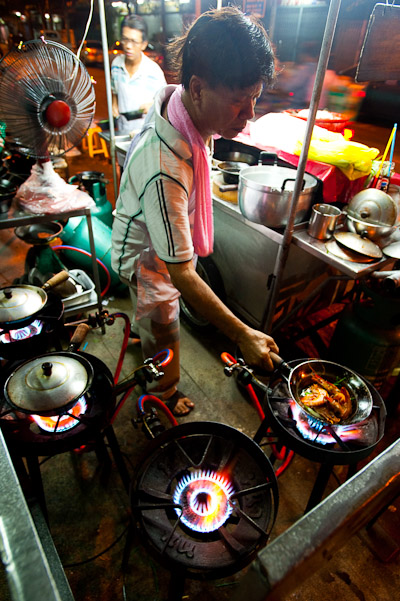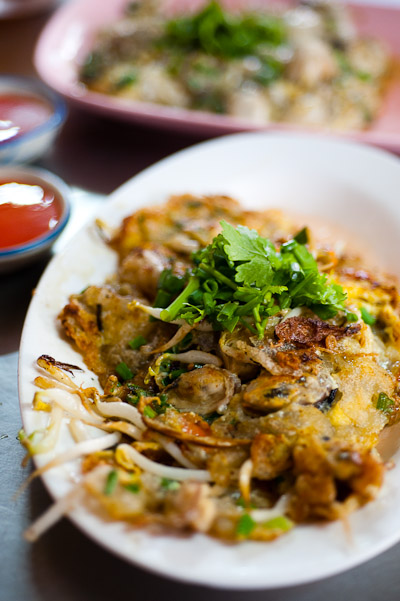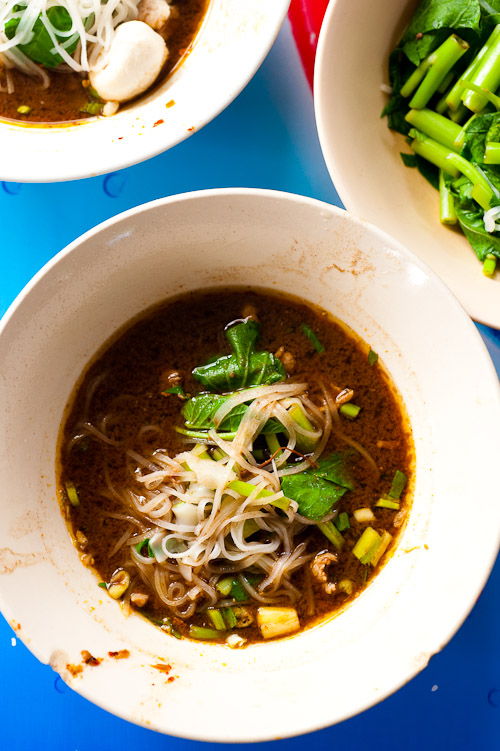 I recently spent a few days up in Chiang Mai eating and cooking with some pretty knowledgeable and and talented folks. There was Andy Ricker, chef/owner of Pok Pok, in Portland Oregon; JJ Goode, a writer based in New York City, with whom Andy and I will be embarking on an exciting and soon-to-be-announced project; and Sunny:
I recently spent a few days up in Chiang Mai eating and cooking with some pretty knowledgeable and and talented folks. There was Andy Ricker, chef/owner of Pok Pok, in Portland Oregon; JJ Goode, a writer based in New York City, with whom Andy and I will be embarking on an exciting and soon-to-be-announced project; and Sunny:

Sunny, a longtime friend of Andy's, is a native of Chiang Mai who grew up in a household that was always cooking, both professionally and domestically. Like many Thai cooks, he cooks without referring to recipes, and appears to have an encyclopedic knowledge of northern Thai cooking. I suspect that much of what is served at Pok Pok has most likely, directly or indirectly, been influenced by Sunny, and understandably so: while in Chiang Mai, I got to sample several examples of his handiwork, including a very refined salad of green mangoes, a northern-style stir-fry of longbeans and eggplant, and a yummy kaeng som, all of which were delicious.
But the most delicious and interesting dish - at least for me - was Sunny's northern-style pork laap:

I suspect that I risk overplaying northern-style laap on this blog, but I really do find it one of the most satisfying of Thai dishes. And despite its deceptively simple appearance, it's also one of the more nuanced and complicated Thai dishes I've encountered. And observing firsthand the fluency and confidence with which Sunny prepared it reminded me that, despite more than a decade in this country, I still know very little about Thai food.
A good laap starts with a good spice mixture, which Sunny's sister makes (in fact, it's the very one used at Pok Pok). But this time Sunny decided to made it himself, from scratch. Starting with a specific mixture of dried spices that included makhwaen, peppercorns and deeplee, he dry-fried them until fragrant, then, with JJ's help, pounded them paste along with galangal, dried chilies, shallots and garlic:

After this was finished, shallots and garlic were fried until crispy, and pork offal (specifically skin, heart and lower intestine) was boiled along with some lemongrass, shrimp paste and turmeric, until tender:

The next step involved mincing raw pork, blood and fresh herbs with a machete-like knife (illustrated at the top of this post). This was done for a long time - at least 20 minutes - despite the fact that we were already starting with ground pork. Obviously we needed a big strong man to do this, and since I was busy taking pics, we settled for Andy. Andy's both a talented cook and a modest guy, which is why I find it a bit strange that he insists on wearing his James Beard medal whenever he cooks:

After being fried in oil until fragrant:

the curry paste mixture was then blended with a bit of the broth left over from boiling the offal, seasoned with salt and stirred into the raw meat along with the sliced offal and the deep-fried crispy shallots and garlic. At this point - at least if you're making a real northern-style raw meat laap - the dish is done:

I ate some (actually, quite a bit) of the raw laap, and it was delicious, with a smooth texture (undoubtedly the result of all that chopping) and a rich flavour. Sunny then took the remaining meat, and working it in a saucepan with a bit more broth and some oil, made the more approachable laap suk or laap khua, 'cooked laap':

We then took both laaps, a cooler of sticky rice, a bucket of greens and some grilled chicken to some of the most appreciative diners I've ever encountered:

Eating at, photographing and writing about restaurants and stalls in Thailand has given me something of a warped perception of the country's food - one that in some ways contrasts with the food that Thai people cook and eat at home. It's always an eye-opening and rewarding opportunity to be able to eat the food of and learn from talented home cooks, and I wish I could do it more often.
 Thanks to leads from both Kin Rob Krung 2 and my buddy J, I was recently pointed in the direction of Lung Chu, a shophouse restaurant selling a short-list of Chinese-style dishes. They do a variety of steamed buns, dumplings and noodles here, but the specialty is khao hor bai bua (ข้าวห่อใบบัว), rice and other bits steamed in a lotus leaf. I sincerely needed pointing in this direction, as I was never previously a fan of this dish, having found previous encounters with it heavy, sweet and oddly enough, somewhat waxy.
Thanks to leads from both Kin Rob Krung 2 and my buddy J, I was recently pointed in the direction of Lung Chu, a shophouse restaurant selling a short-list of Chinese-style dishes. They do a variety of steamed buns, dumplings and noodles here, but the specialty is khao hor bai bua (ข้าวห่อใบบัว), rice and other bits steamed in a lotus leaf. I sincerely needed pointing in this direction, as I was never previously a fan of this dish, having found previous encounters with it heavy, sweet and oddly enough, somewhat waxy.










































































